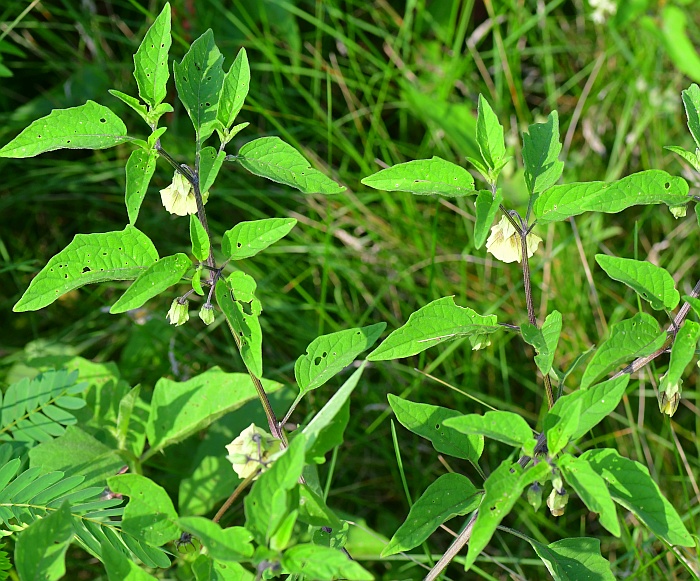Physalis longifolia Nutt.
Common Ground Cherry

Native
CC = 2
CW = 5
MOC = 81
© SRTurner
Physalis longifolia Nutt.Common Ground Cherry | |
 |
Native CC = 2 CW = 5 MOC = 81 |
© SRTurner |
|
Family - Solanaceae Habit - Perennial forb with deep-set, long-creeping rhizomes. Stems - To 80 cm, erect or ascending, unbranched or usually with few to several, ascending to loosely ascending branches, often purplish-tinged, glabrous or sparsely pubescent with short, upward-appressed, unicellular and few-celled, nonglandular hairs 0.1-0.5 mm long.
Leaves - Alternate, simple, short- to long-petiolate. Blades 2.5-10.0 cm long, lanceolate to ovate or elliptic-ovate, angled or tapered to a sharply pointed tip, broadly angled to rounded or more or less truncate at the base, the margins entire, irregularly sinate, or sparsely and irregularly toothed, minutely hairy, nonglandular, the teeth mostly bluntly pointed, relatively shallow and broad, the surfaces green to dark green when fresh, drying uniformly green (lacking orangish tinging or patches), glabrous or sparsely pubescent with minute, appressed, nonglandular, mostly unicellular hairs.
Inflorescence - Single axillary flowers. Flower stalks 5-20 mm long, becoming elongated to 15-35 mm at fruiting. Flowers - Pendent. Calyces 7-12 mm long at flowering, the lobes 3-6 mm long, the outer surface glabrous or sparsely pubescent with minute, appressed-ascending hairs at flowering, glabrous or very sparsely hairy at fruiting, at fruiting, becoming elongated to 20-40 mm long, shallowly 10-angled or 10-ribbed, rounded to very shallowly concave at the base, mostly remaining green, occasionally pale brown to tan with age. Corollas 10-20 mm long, pale yellow to lemon yellow or yellow, the inner surface with 5 prominent purplish brown to bluish purple spots toward the base (these often merged into a ring or appearing smudged). Stamens with broad filaments about as wide as (or occasionally wider than) the anthers, the anthers 2-4 mm long, yellow, occasionally bluishtinged or each anther sac with a bluish longitudinal line along the zone of dehiscence, arched but not coiled after dehiscence.
Fruit - Berries 0.8-1.0 cm long, green or yellow, enclosed in persistent inflated papery calyx. Seeds 1.5-2.5 mm in longest dimension, more or less kidney-shaped to asymmetrically ovate, flattened, the surface minutely pitted, sometimes only faintly so, more or less shiny, light yellow to orangish yellow or light yellowish brown, lacking wings.
Flowering - May - September. Habitat - Forests, streambanks, bottomland prairies, swales, saline marshes, fens, pond margins, swamps, sloughs, savannas, bluffs, ditches, pastures, fields, railroads, roadsides, and open to shaded, disturbed areas. Origin - Native to the U.S. Lookalikes - Other species of Physalis. Other info. - This is one of the more common species of ground cherry in Missouri, found across most of the state, and also occurring in some form across most of the continental U.S., particularly in the central region. The plant can look like a little "tree" with a single straight stem and "canopy" of branches near the apex, or it can grow very low and almost sprawl. Important characters for identification include relatively narrow leaves (lanceolate to ovate but not broadly ovate), stems and calyces which are sparsely pubescent at most with hairs which are not glandular, and relatively large flowers with dark purple markings at their centers. The species is further subdivided into var. longifolia, with narrower leaves, and var. subglabrata, with slightly broader leaves. The distinction is subtle. Photographs taken off Hwy H, Shannon County, MO., 7-30-04 (DETenaglia); also at Marais Temps Clair Conservation Area, St. Charles County, MO, 7-25-2024 (SRTurner). |